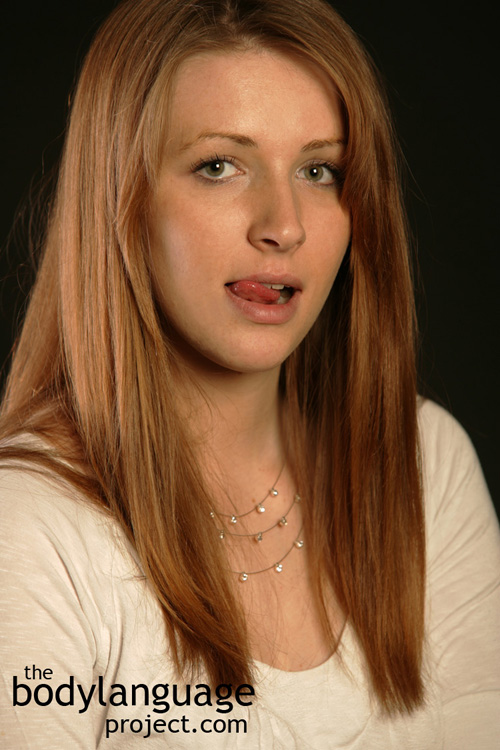Body Language of Lip Licking
 Cue: Lip Licking
Cue: Lip Licking
Synonym(s): Moistening The Lips, Wetting The Lips, Frequent Lip Licking, Excessive Lick Licking.
Description: The tongue is run over the lips usually repeatedly or in succession.
In One Sentence: Lip licking demonstrates a need for pacifying or, in the right context, sexual interest.
How To Use it: While habitual lip licking should be avoided since it shows anxiety, women can use obvious lip licking coupled with eye contact to show sexual interest. The cue must be done in context, with focus gaze, eyes should make eye contact or be looking squarely to body parts they find arousing. When done correctly, the signal can tell men that there is unequivocal sexual interest. This will cause men to pursue if the feeling is reciprocal.
Lip licking can also be used to show others that you are getting ready to speak. This is made obvious as we often moisten the lips to facilitate communication.
Context: a) General b) Dating.
Verbal Translation: “I’m licking my lips to moisten them, to prepare for speaking or kissing, or to sooth myself.”
Variant: When pacifying, the tongue can be run over the teeth to pacify. The tongue sometimes pokes out of the mouth during periods of high concentration and focus. See Running The Tongue Over The Teeth or Lips.
Cue In Action: a) She wanted to interject. Just before speaking, she wet her lips and parted them slightly. a) He was getting ready for the exam and repeatedly licked his lips in anticipation. He needed to sooth his excited nerves. b) She was hot for the guy in the suite. Subconsciously, she licked her lips while her eyes darted toward his mouth.
Meaning and/or Motivation: An increase in lip licking is due to a decrease in saliva production which is in turn caused by high stress. Conversely, high blood flow to the lips is due to sexual arousal in a dating context. Alternatively, licking the lips is in effort to moisten them to speak.
When done by women in courtship lip licking indicates sexual interest especially if done frequently, with eye contact and in the proper context. Lips are said to imitate the female labia and licking them draws attention by both making them shiny, and also by movement – of the tongue. Lips are also licked just before kissing and can be a kiss indicator if the lips are licked while looking at the lips of another.
Repeated or excessive licking serves to pacify and sooth negative feelings. In this gesture, the tongue can be seen darting out of the mouth, swiping the top lip on the way and curling under to swipe the bottom lip as it reenters. A person that licks as part of his idiosyncratic behaviour is usually one that has underlying emotional turmoil.
The lips can sometimes be licked as a prelude before speaking to make communication easier. Other times, lip licking has no emotional meaning at all and only serves a practical purpose – to moisten dry or chapped lips.
Cue Cluster: Cues associated with lip licking will depend on the context. Usually lip licking in dating signifies arousal if eye contact anchors the cue. Eyes that look toward a man’s mouth is a good indication that a kiss is welcomed. Lip licking before presenting to an audience often shows anxiety and stress due to a dry mouth, as does excessive lip licking during a stressful event.
Body Language Category: Auto contact or self touching, Autoerotic touching, Courtship displays, Emotional body language, Stroking body language, Indicators of sexual interest (IOsI), Intention movements, Microgestures, Nervous body language, Pacifying body language, Stressful body language.
Resources:
Barroso, Felix ; Feld, Jason. Self-touching and attentional processes: The role of task difficulty, selection stage, and sex differences. Journal of Nonverbal Behavior. 1986. 10(1): 51-64.
Butzen, Nathan David ; Bissonnette, Victor ; Mcbrayer, Dan. Effects of modeling and topic stimulus on self-referent touching. Perceptual and motor skills. 2005. 101(2): 413-20.
Broome, Marion E.. Helping Parents Support Their Child In Pain. Pediatric Nursing. 2000. 26(3): 315.
Bornstein, Marc H. ; Tamis-Lemonda, Catherine S. Maternal responsiveness and infant mental abilities: Specific predictive relations. Infant Behavior and Development. 1997. 20(3): 283-296.
Buckley, V., & Semple, S. (2012). Evidence that displacement activities facilitate behavioural transitions in ring-tailed lemurs. Behavioural Processes, 90, 433–435.
Bernal, Gilda Rios ; Wortham, Suec. How to Calm Children through Massage. Childhood Education. 1997. 74(1): 9-14.
Bouhuys, A.L. ; Jansen, C.J. ; van den Hoofdakker, R.H. Analysis of observed behaviors displayed by depressed patients during a clinical interview: relationships between behavioral factors and clinical concepts of activation. Journal of Affective Disorders. 1991. 21(2): 79-88.
Bouhuys, A.L. ; Beersma, Domien G.M. ; van den Hoofdakker, Rutger H. Observed behavior as a predictor of the response to sleep deprivation in depressed patients. Psychiatry Research. 1989. 28(1): 47-61.
Berridge CW,Mitton E, ClarkW, Roth RH. 1999. Engagement in a non-escape (displacement) behavior elicits a selective and lateralized suppression of frontal cortical dopaminergic utilization in stress. Synapse 32:187–197.
Caplovitz Barrett, Karen. The origins of social emotions and self-regulation in toddlerhood: New evidence. Cognition & Emotion. 2005. 19(7): 953-979.
Castles, Duncan L. ; Whiten, Andrew ; Aureli, Filippo. Social anxiety, relationships and self-directed behaviour among wild female olive baboons. Animal Behaviour. 1999. 58(6): 1207-1215.
Clark, A. Attracting Interest: Dynamic Displays of Proceptivity Increase the Attractiveness of Men and Women. Evolutionary Psychology. 2008., 6(4), 563-574.
D’alessio, M. ; Zazzetta, A. Development of Self-Touching Behavior in Childhood. Perceptual and Motor Skills. 1986. 63(1): 243-253.
Dosmukhambetova, D., and Manstead, A. Strategic Reactions to Unfaithfulness: Female Self-Presentation in the Context of Mate Attraction is Link to Uncertainty of Paternity. Evolution and Human Behavior. 2011. 32, 106-107.
Goldberg, Shelly ; Rosenthal, Robert. Self-touching behavior in the job interview: Antecedents and consequences. Journal of Nonverbal Behavior. 1986. 10(1): 65-80.
Guéguen, Nicolas. Does Red Lipstick Really Attract Men? An Evaluation in a Bar. International Journal of Psychological Studies. 2012. 4(2)
Guéguen, Nicolas and Céline Jacob. Lipstick And Tipping Behavior: When Red Lipstick Enhance Waitresses Tips. International Journal of Hospitality Management, 2012; 31: 1333– 1335.
http://bodylanguageproject.com/articles/men-prefer-women-who-dress-in-red-and-wear-red-lipstick-how-to-earn-more-tips-or-favours-from-men/
Goldberg, Shelly ; Rosenthal, Robert. Self-touching behavior in the job interview: Antecedents and consequences. Journal of Nonverbal Behavior. 1986. 10(1): 65-80.
Hernandez-Reif, Maria ; Diego, Miguel ; Field, Tiffany. Preterm infants show reduced stress behaviors and activity after 5 days of massage therapy. Infant Behavior and Development. 2007. 30(4): 557-561.
Harrison, Lynda Law. The use of comforting touch and massage to reduce stress for preterm infants in the neonatal intensive care unit. Newborn and Infant Nursing Reviews. 2001. 1(4): 235-241.
Hennessy, Michael B ; T. Williams, Michael ; Miller, Deborah D ; Douglas, Chet W ; Voith, Victoria L. Influence of male and female petters on plasma cortisol and behaviour: can human interaction reduce the stress of dogs in a public animal shelter?
Applied Animal Behaviour Science. 1998. 61(1): 63-77.
Harrigan, Jinni A. Self-touching as an indicator of underlying affect and language processes. Social Science & Medicine. 1985. 20(11): 1161-1168.
Harrigan, Jinni A.; Karen S. Lucic; Denise Kay; Anne McLaney and Robert Rosenthal. Effect of Expresser Role and Type of Self-Touching on Observers’ Perceptions. Journal of Applied Social Psychology. 1991. 21(7): 585-609.
Heaven, Laura ; Mcbrayer, Dan ; Prince, Bob. Role of sex in externally motivated self-touching gestures. Perceptual and motor skills. 2002. 95(1): 289-94.
Heaven, L ; Mcbrayer, D. External motivators of self-touching behavior. Perceptual and motor skills. 2000. 90(1): 338-42.
Harrigan, Jinni A. Self-touching as an indicator of underlying affect and language processes. Social Science & Medicine. 1985. 20(11): 1161-1168.
Huflejt-Łukasik M, Czarnota-Bojarska J (2006) Short Communication: Selffocused attention and self-monitoring influence on health and coping with stress. Stress Health 22: 153–59.
Heaven, Laura ; Mcbrayer, Dan ; Prince, Bob. Role of sex in externally motivated self-touching gestures. Perceptual and motor skills. 2002. 95(1): 289-94.
Heaven, L ; Mcbrayer, D. External motivators of self-touching behavior. Perceptual and motor skills. 2000. 90(1): 338-42.
Hall, Jeffrey A. and Chong Xing. The Verbal and Nonverbal Correlates of the Five Flirting Styles. Journal of Nonverbal Behavior. 2015. 39:41–68. DOI 10.1007/s10919-014-0199-8
http://bodylanguageproject.com/articles/first-12-minutes-flirting-using-nonverbal-communication-study-reveals-26-body-language-cues-attraction/
Katza, Carmit; Irit Hershkowitz; Lindsay C. Malloya; Michael E. Lamba; Armita Atabakia and Sabine Spindlera. Non-Verbal Behavior of Children Who Disclose or do not Disclose Child Abuse in Investigative Interviews. Child Abuse & Neglect. 2012. 36: 12-20.
http://bodylanguageproject.com/articles/reading-nonverbal-behaviour-child-abuse-cases-encourage-children-divulge-information-truth-telling
Kirschbaum C, Pirke K-M, Hellhammer DH. 1993. The ‘Trier Social Stress Test’: a tool for investigating psychobiological stress responses in a laboratory setting. Neuropsychobiology 28: 76–81.
Kochanska, G., Coy, K. C., & Murray, K. T. (2001). The development of self-regulation in the first four years of life. Child Development, 72, 1091–1111.
Kochanska, G., Murray, K. T., & Harlan, E. T. (2000). Effortful control in early childhood: Continuity and change, antecedents, and implications for social development. Developmental Psychology, 36, 220–232.
Maestripieri D, Schino G, Aureli F, Troisi A. 1992. A modest proposal: displacement activities as an indicator of emotions in primates. Anim Behav 44:967–979.
Mohiyeddini, C., Bauer, S., & Semple, S. (2013a). Displacement behaviour is associated with reduced stress levels among men but not women. PLoS One, 8, e56355.
Mohiyeddini, C., Bauer, S., & Semple, S. (2013b). Public self-consciousness moderates the link between displacement behaviour and experience of stress in women. Stress, 16, 384–392.
Mohiyeddini, C., & Semple, S. (2013). Displacement behaviour regulates the experience of stress in men. Stress, 16, 163–171.
Moore, Monica. Courtship Signaling and Adolescents: Girls Just Wanna Have Fun. Journal of Sex Research. 1995. 32(4): 319-328.
http://bodylanguageproject.com/articles/girls-just-want-to-have-fun-the-origins-of-courtship-cues-in-girls-and-women/
Navarro, Joe. 2008. What Every BODY is Saying: An Ex-FBI Agent’s Guide to Speed-Reading People. William Morrow Paperbacks.
Pecora, Giulia ; Addessi, Elsa ; Schino, Gabriele ; Bellagamba, Francesca. Do displacement activities help preschool children to inhibit a forbidden action? Journal of Experimental Child Psychology. 2014. 126: 80-90.
Schino G, Perretta G, Taglioni AM, Monaco V, Troisi A. 1996. Primate displacement activities as an ethopharmacological model of anxiety. Anxiety 2:186–191.
Sturman, Edward D. Invluntary Subordination and Its Relation to Personality, Mood,
and Submissive Behavior. Psychological Assessment. 2011. 23(1): 262-276 DOI: 10.1037/a0021499
http://bodylanguageproject.com/articles/nonverbal-submission-men-women-depression-critical-examination-use-disuse-submission/
Schino G, Perretta G, Taglioni AM, Monaco V, Troisi A. 1996. Primate displacement activities as an ethopharmacological model of anxiety. Anxiety 2:186–191.
Supplee, Lauren H ; Skuban, Emily Moye ; Shaw, Daniel S ; Prout, Joanna. Emotion regulation strategies and later externalizing behavior among European American and African American children. Development and Psychopathology. 2009. 21(2): 393-415.
Smith, John, Julia Chase, and Anna Lieblich (1974). “Tongue Showing.” In Semiotica (Vol. 11, No. 3), pp. 201-46.
Stern, Daniel and Estelle Bender (1974). “An Ethological Study of Children Approaching a Strange Adult.” In Richard Friedman et al. (Eds.), Sex Differences in Behavior (New York: John Wiley and Sons), pp. 233-58.
Troisi A. 2002. Displacement activities as a behavioral measure of stress in nonhuman primates and human subjects. Stress 5: 47–54.
Troisi A (1999) Ethological research in clinical psychiatry: the study of nonverbal behaviour during interviews. Neurosci Biobehav Rev 23: 905–913.
Tamres L, Janicki D, Helgeson VS (2002) Sex differences in coping behaviour: a
meta-analytic review. Personal Soc Psychol Rev 6: 2–30.






